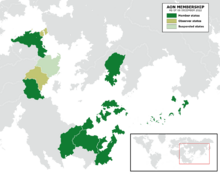Association of Ozeros Nations: Difference between revisions
Hierophant (talk | contribs) mNo edit summary |
Hierophant (talk | contribs) No edit summary |
||
| Line 38: | Line 38: | ||
|title = Members | |title = Members | ||
|{{flag|Ankat}} | |{{flag|Ankat}} | ||
|{{flag|Daobac}} | |||
|{{flag|Fahran}} | |{{flag|Fahran}} | ||
|{{flag|Kajera}} | |{{flag|Kajera}} | ||
Revision as of 23:35, 26 November 2022
Association of Ozeros Nations
| |||
|---|---|---|---|
|
Flag | |||
 Map of Member Countries | |||
| Official languages | |||
| Type | Regional Organization | ||
| Member states | |||
| Leaders | |||
| Thaumai Sim Cuah | |||
| Formation | |||
• Forming Conference | April 17th, 1952 | ||
• Official Declaration and Treatise | August 4th, 1957 | ||
| Currency | List
| ||
AON, officially the Association of Ozeros Nations, is an intergovernmental organization whose primary focus lies on the development and integration of the Ozeros Region irrespective of political or economic status. Composing of several member states between all three continents that border the Ozeros Sea, the union promotes environmental, infrastructural, educational, and sociocultural development amongst themselves and the greater region.
AON states are not limited or restricted in their outward levels of cooperation, with states able to cooperate in other economic or political unions whilst retaining membership within the regionally focused organization. Because of the varied socio-political statuses of the nations within AON, the body is recognized as one of the most effective networks for cooperation and engagement, hailed as an influential environmental body, and maintains a collective network of allies and partners that spans the near entirety of Ajax.
History
Prior to the formation of the Association, bilateral tensions held between Pulau Keramat and Onekawa-Nukanoa had been a mounting pressure on the eastern Ozerosi region, derrived from contrasting political systems and a growing globalistic expectation of deviation from one another. Because of this, and a mutual desire to further represent hegemonic levels of influence, the two nations were inherently engaged in a tense contest to one another in terms of influence, networks, and capacity, namely based in sociocultural promotion as to display quality of life of their respective nations, whilst also maintaining a hard presence in the Karaihe, in mounting levels of militaristic escalation and defense system growth.
However, a conference was called by surrounding states, namedly Ankat and Zanzali, who's own populations, governance and economies had been notably impacted by the threat of warfare in the region, and thus took a proactive stance on deescalation, and formulating a plan to reconcile from this differentiation, especially given the suspect belief that foreign interests were promoting the two nations in order to profit from war-time spending. This was the primary, formatory conference that took place on the 17th of April, 1952, known as the Karaihe Conference.
Organizational Structure
Kariahe Border Control Agreement
Pulau Keramat, Zanzali, Pulacan, and Onekawa-Nukanoa share open borders, allowing their citizens unrestricted freedom of movement in all four countries. Other AON-Member countries have more relaxed identity document requirements, and controls on entry are carried out at the first country of entry.
